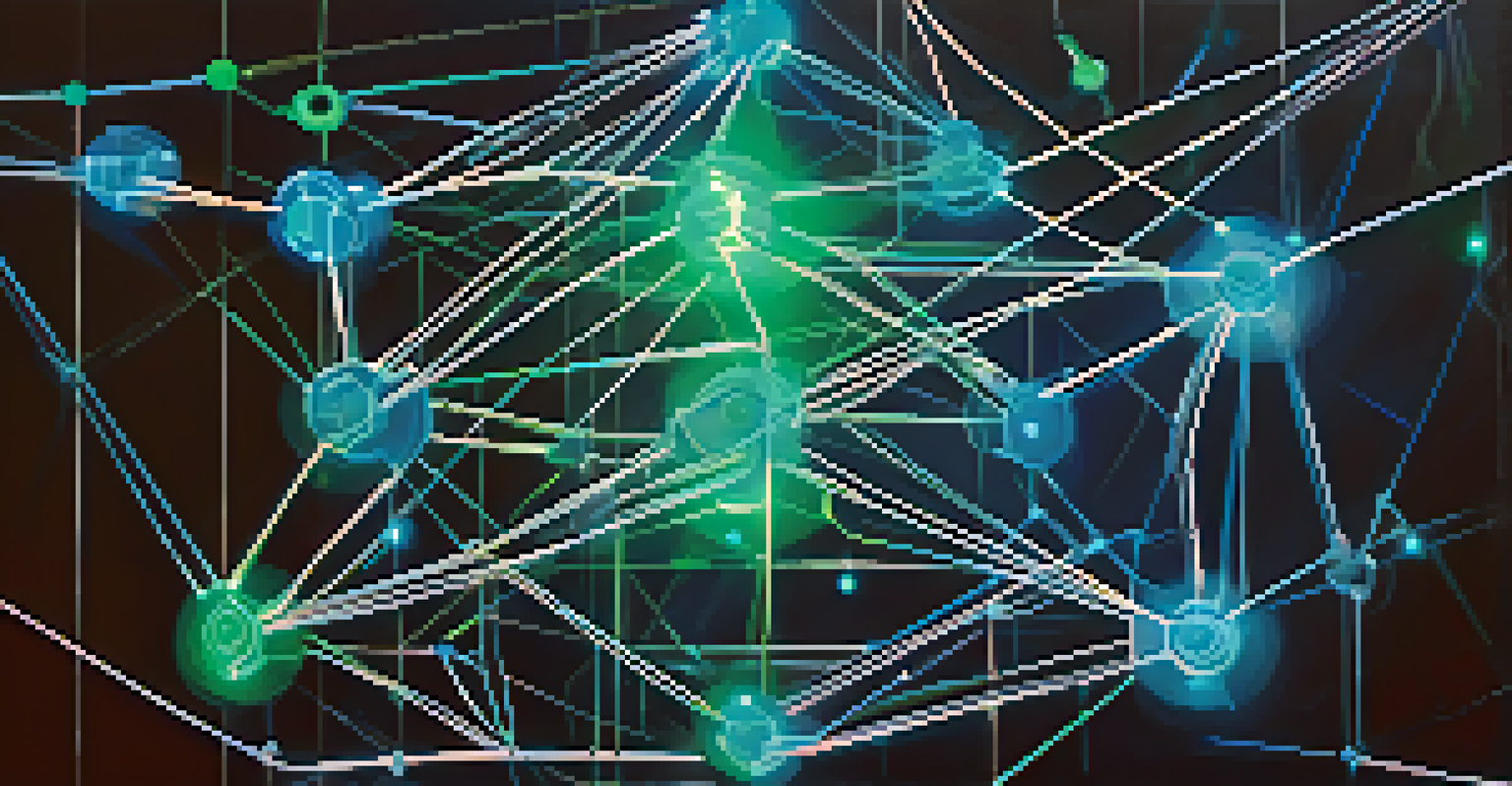Decentralization and Ethereum: The Backbone of Web3 Innovation

Understanding Decentralization in the Digital Age
Decentralization is a key principle that reshapes how we interact online. Unlike traditional systems, where a central authority controls the data, decentralization distributes power among users. This shift not only enhances privacy but also increases resilience against failures or attacks. Imagine a library where every book is owned by its reader rather than the library itself; that's the essence of decentralization.
The internet is becoming the town square for the global village of tomorrow.
In the digital landscape, decentralization allows users to own their data and digital identities. This concept stands in stark contrast to conventional platforms, where user data is often exploited for profit. By empowering individuals, decentralization fosters a sense of ownership, making the internet more democratic and accessible to everyone. Consider it the difference between renting an apartment and owning a home; it’s about control and security.
Moreover, decentralization encourages innovation by providing a level playing field for developers. Without a central gatekeeper, anyone can create and deploy applications, leading to a rich ecosystem of ideas and solutions. This openness is crucial for the growth of new technologies, enabling more creativity and experimentation. It’s like a community garden where everyone can plant their seeds and nurture their growth.
Ethereum: A Pioneering Force in Decentralization
Ethereum stands out as a leading platform for decentralized applications (dApps). Launched in 2015, it introduced smart contracts, which automate processes without intermediaries. This innovation enables developers to build a wide range of applications, from finance to gaming, all operating on a decentralized network. Think of Ethereum as a robust toolbox, providing everything needed to create innovative digital solutions.

One of Ethereum's biggest achievements is its vibrant community of developers and users. This collaborative environment drives constant improvements and new features, ensuring the platform evolves alongside user needs. The community acts like a hive, buzzing with ideas and support, making it a fertile ground for innovation. With each update and new project, Ethereum strengthens its position as the backbone of Web3.
Decentralization Empowers Users
Decentralization allows individuals to own their data and digital identities, fostering greater privacy and control.
Additionally, Ethereum's transition to a proof-of-stake consensus mechanism marks a significant shift towards sustainability. By reducing energy consumption, it addresses environmental concerns associated with blockchain technology. This move not only aligns with global efforts to combat climate change but also attracts a broader audience interested in ethical technology. It’s like trading a gas-guzzling car for an electric vehicle—better for the planet and the future.
The Role of Smart Contracts in Web3
Smart contracts are self-executing agreements with the terms directly written into code. They eliminate the need for intermediaries, making transactions more efficient and cost-effective. Imagine having a vending machine that dispenses your favorite snack without needing a cashier; that’s the convenience smart contracts offer. This automation allows for seamless interactions between parties.
Decentralization is the technology that can create value and trust in a digital world.
The versatility of smart contracts opens up endless possibilities across various industries. From real estate to supply chain management, they can streamline processes and reduce human error. For instance, in real estate, smart contracts can facilitate automatic property transfers upon payment completion. It’s like having a digital escrow agent that works around the clock without a fee.
Moreover, smart contracts enhance trust in digital transactions. Since the code is visible and immutable on the blockchain, parties can be confident that the terms will be honored. This transparency fosters a sense of security, encouraging more people to engage with decentralized systems. Think of it as a handshake backed by a legally binding document—everyone knows what to expect.
Decentralized Finance: Transforming Traditional Banking
Decentralized Finance (DeFi) is revolutionizing how we perceive and interact with financial services. By leveraging blockchain technology, DeFi platforms offer services like lending, borrowing, and trading without traditional banks. This shift democratizes access to financial resources, allowing anyone with an internet connection to participate. It’s akin to having a bank in your pocket that operates 24/7.
Furthermore, DeFi promotes financial inclusion, especially in underserved regions. Many people lack access to banking services, but with DeFi, they can engage in economic activities and manage their assets. This accessibility empowers users to take control of their financial futures, similar to how mobile technology has transformed communication in remote areas.
Ethereum Drives Innovation
Ethereum serves as a foundational platform for decentralized applications, enabling a vibrant community and sustainable technology.
Importantly, DeFi also encourages innovation in financial products. Developers can create unique offerings that cater to niche markets or specific user needs. This flexibility leads to a diverse range of solutions, from yield farming to decentralized exchanges. It’s like a buffet where everyone can find something that suits their taste—no matter how unique.
NFTs: A New Era of Digital Ownership
Non-Fungible Tokens (NFTs) have emerged as a groundbreaking way to establish ownership of digital assets. Unlike cryptocurrencies, which are interchangeable, NFTs represent unique items, such as art, music, or virtual real estate. This uniqueness allows creators to monetize their work directly, cutting out middlemen. Imagine owning a one-of-a-kind painting that no one else can replicate—that’s the power of NFTs.
The rise of NFTs has sparked a cultural shift in how we value digital content. Artists and creators are now able to sell their work directly to consumers, fostering stronger connections with their audiences. This new model not only benefits creators but also allows collectors to invest in digital art and rare items. It’s like moving from a gallery system to a direct-to-consumer model, where everyone wins.
Additionally, NFTs pave the way for innovative uses beyond art and collectibles. They can represent ownership of real-world assets, event tickets, or even virtual land in metaverses. This versatility showcases the potential of NFTs to redefine ownership and value in the digital realm. Think of it as a digital certificate of authenticity that opens doors to new experiences and opportunities.
Building a Decentralized Identity on the Blockchain
In a world where personal data is often mishandled, decentralized identity solutions offer a refreshing alternative. Instead of relying on centralized authorities to verify identity, blockchain technology allows individuals to own and control their personal information. This shift empowers users to manage their identities securely and privately, much like having a digital passport that only you can access.
Decentralized identities can streamline processes across various sectors, from healthcare to finance. For instance, patients can share their medical records with providers without compromising their privacy. This capability not only enhances security but also improves efficiency in data sharing. It’s like having a master key that opens multiple doors without the need for a locksmith.
DeFi Enhances Financial Access
Decentralized Finance democratizes financial services, providing opportunities for inclusion and innovation worldwide.
Moreover, decentralized identity solutions can significantly reduce identity fraud. With blockchain’s transparent and immutable records, verifying identities becomes more reliable. Users can confidently engage in online transactions, knowing their information is protected. Picture it as a digital fortress, safeguarding your personal data against unwanted access.
The Future of Web3: Challenges and Opportunities
While Web3 holds immense promise, it also faces challenges that must be addressed. Scalability is a primary concern, as increased user activity can strain blockchain networks. Solutions like layer-2 scaling and sharding are being explored to enhance performance. It’s akin to expanding a highway to accommodate more traffic, ensuring smooth travel for everyone.
Another challenge is regulatory uncertainty surrounding decentralized technologies. Governments are still figuring out how to approach cryptocurrencies, DeFi, and NFTs. Clear regulations could foster innovation while protecting users, but finding the right balance is crucial. Think of it as navigating uncharted waters; the goal is to reach new shores without capsizing.

Despite these hurdles, the opportunities for innovation in Web3 are vast. As more people embrace decentralization, new use cases and applications will continue to emerge. The collective creativity of developers and users can drive Web3 to new heights, shaping a digital future that prioritizes user empowerment and privacy. It’s like planting seeds in a garden; with proper care, they can blossom into a thriving ecosystem.